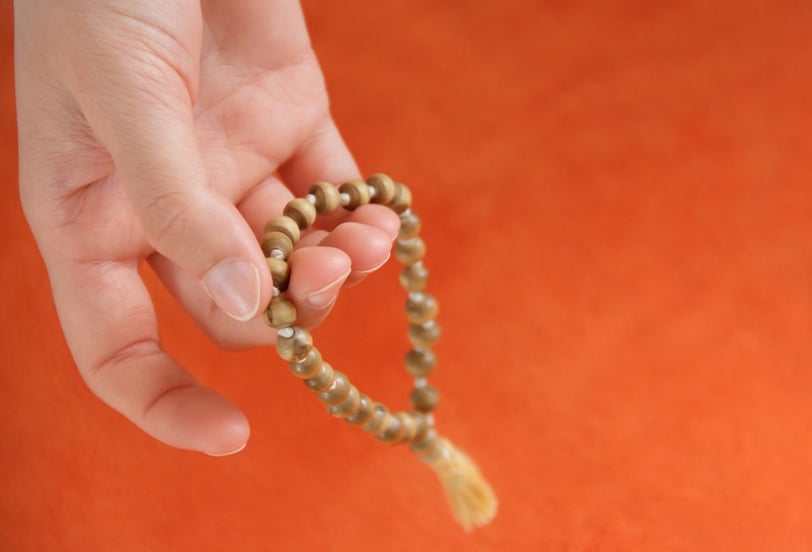How to do Mantra Japa
To fully experience the advantages of mantra recitation, it's important to synchronize the mantra with your breathing. It's best to focus on just one mantra for effective alignment. Having multiple mantras is not recommended. A strong belief in your chosen mantra and its associated deity is essential, as they will offer protection to the practitioner, depending on their karmic circumstances. The method outlined here is intended for a single mantra, and attempting to align more than one with your breath will not provide any benefits to the seeker.


Take a seat that feels comfortable, ideally one that offers good back support. This is important, especially in advanced stages, as we tend to let our heads droop, making back support necessary. You won’t need a japa mālā for this practice. Next, let’s practice Nāḍi Śodhana Prāṇāyāma, or alternative nostril breathing, for a few rounds. This should be combined with yogic breathing. When you inhale, gently push your abdomen forward from the diaphragm toward the lower abdomen. Although you might not clearly see the lower abdomen expand during inhalation, be mindful of it. As you exhale, contract the lower abdomen and gradually draw it back toward the diaphragm. Remember, yogic breathing forms the foundation for all prāṇāyāma practices, and it should always be done on an empty stomach. Unlike other breathing exercises, you don’t need to count during the inhalation, retention (antar kumbhaka), exhalation, or holding (bāhya kumbhaka) before the next inhalation—doing what feels comfortable is key here. A single round can comfortably take about 30 to 40 seconds. To clarify, one complete round consists of inhaling through the left nostril, holding the breath (antar kumbhaka), exhaling slowly through the right nostril, holding the breath again (bāhya kumbhaka), inhaling through the right nostril, holding the breath (antar kumbhaka), and finally exhaling through the left nostril. If you’re short on time, completing five rounds will suffice.
1. Begin by inhaling through your left nostril (pūraka) while gently closing the right nostril with your right thumb.
2. Hold your breath (antar kumbhaka) by closing both nostrils—use your right hand's little and ring fingers to close the left nostril.
3. Exhale through your right nostril (recaka) by lifting your thumb off the right nostril.
4. Pause for a few seconds without inhaling (bāhya kumbhaka).
5. Inhale through your right nostril (pūraka).
6. Hold the breath again (antar kumbhaka).
7. Exhale through your left nostril (recaka).
8. Again, pause for a few seconds without inhaling (bāhya kumbhaka).
9. Continue the process by repeating from step 1.
For the same practice, you can keep both nostrils open. While inhaling, tilt your head slightly backward, and during exhalation, bring your head forward. Remember to keep your chin from touching your chest.
You can adjust this draft to further tailor it to your needs and use Grammarly Free's suggestions to ensure your final product shines.
it's important to consciously slow down our breathing. Ideally, aim for a rate of about 3 breaths per minute, give or take 1 or 2. With regular practice, we can gradually lower the breathing pace—even lower is preferable. Once you have settled into this slower breathing, which will naturally become shallower, focus your gaze on the tip of your nose, particularly the nostril openings highlighted in green in the image. As you inhale, visualize the prāṇā moving towards the ājñācakra, represented as a star between the eyes in the accompanying image. This sensation of prāṇā’s movement can be quite palpable. Begin to recite your japa mantra within the ājñācakra. When your concentration deepens, the japa mantra will seamlessly integrate into your subconscious, and the conscious repetition will effortlessly fade away on its own.
After a few minutes, typically around 5 to 10, you may start to notice a pulsation or vibrations at the ājñācakra. As these vibrations intensify, it's important to direct this energy towards the pineal and pituitary glands, as illustrated by the dark line in Image 3 below. The red line emanating from the pineal gland demonstrates the flow of energy towards the back of the head.
Once we recognize that our ājñācakra is active, we can shift our awareness from the ājñācakra to the sahasrāra, as illustrated in the image above. This transition can be assisted through our eye movements and controlled breathing. When done correctly, this can naturally lead us into a trance state. We should gently direct our gaze upwards toward the sahasrāra for just a brief moment to guide the energy effectively from the ājñācakra to the sahasrāra. It's important to avoid excessive movement, as it could harm the retinal nerves.
